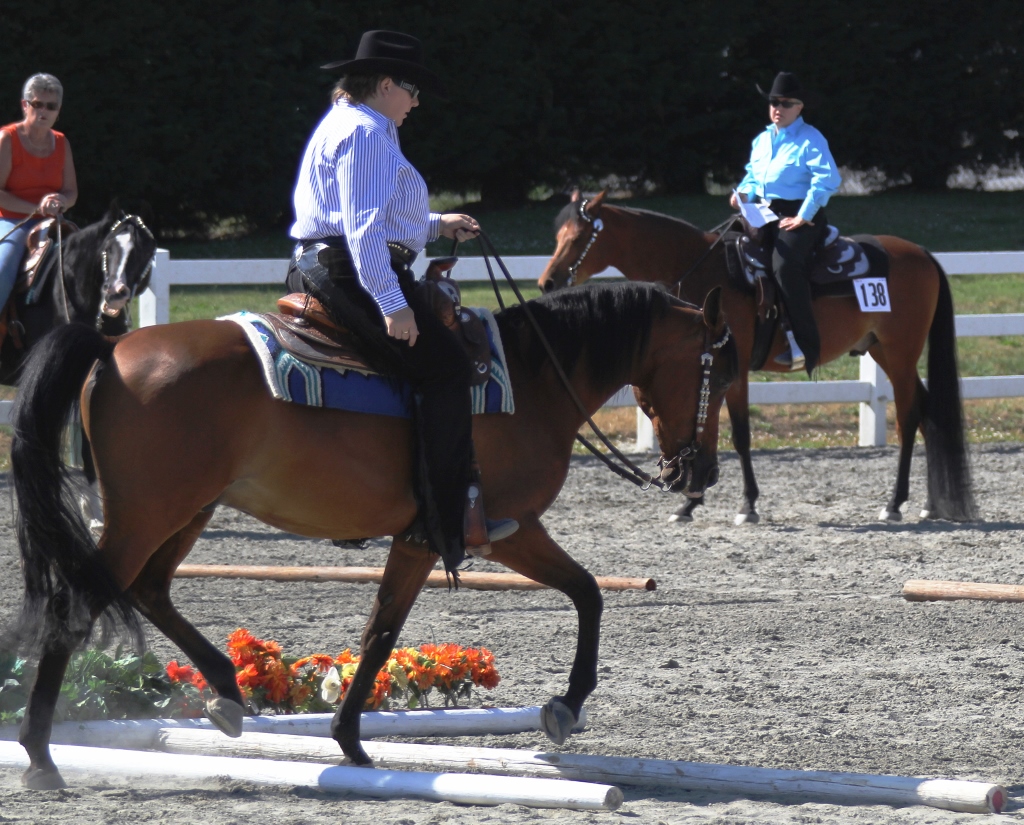by Jackie Davenport

As you read last month, arena trail is all about negotiating obstacles with style and agility while, ideally, never touching a thing. Horses must be able to work over and through obstacles and turn and maneuver in tight spaces and this can be challenging. However, practicing arena trail is very rewarding for both horse and rider, whether you just want to vary your regular workout or your goal is to show.
To get off to a good start, your horse should already have consistent gaits and should possess all the basic skills of a well broke horse. This includes a solid back-up, side-pass and turns on the haunches and forehand. The horse should also be supple, circle well and turn easily showing little or no resistance. I like to start my horses by setting up a simple jog/trot obstacle to negotiate. The jog/trot is a good training gait and helps a horse achieve cadence as well as confidence over poles. The first time I ride a horse over poles I set out only three: a single pole somewhere in the middle of the arena with two poles about 20’ away that are set parallel to each other at a jog or trot stride apart. I’ll then build a well cadenced gait and, when I have it, I’ll jog over the single pole and around and through the open space between the two parallel poles. This may sound simple, but it is challenging enough for the beginner. Remember, the goal is to build confidence. If all goes well, I’ll slowly build on that routine by going over the parallel poles then around and through them while developing a good arc and maintaining cadence. I go over the two then loop back around and halt between them to work on a balanced halt. Later, I may back between the two poles to work on a straight, unresisting back-up.
These exercises are not just for the horse, they are also good for riders. Poles can help a rider’s legs as they work to keep their horse arced and striding evenly. They can help a rider be more deliberate in their riding by, for example, aiming for the center of each pole or backing just one step at a time.
When I think the horse is ready, I’ll set up a lope obstacle. I start with just one pole, somewhere off the rail but at a right angle to it. When the horse easily lopes that one pole, keeping a correct stride, relaxed frame and not swapping leads, then I’ll add a second pole a stride away. I’ll keep a single pole somewhere nearby to go back to as encouragement if the double poles prove to be more of a challenge than expected. As the horse and rider develop, I add all these obstacles together and work on upward and downward transitions between them.
I work all my beginning arena trail horses with two hands because it helps control their shoulders. It’s important that the horse be “good in the bridle.” If the horse is pulling or rooting with his nose, it will be impossible for him to go over poles in a pleasing manner and, as obstacles get more complex it becomes impossible to do the work.
Over time, I keep adding obstacles: cones to serpentine through; various circles with stops and pivots; back-ups with turns; stopping and standing quietly by the gate. Until the horse can stop and stand patiently at the gate, I don’t go any further. The next step will be opening and closing the latch while the horse stands still and, separately, side passing up to the gate and standing still. Eventually, I’ll start to teach a simple lead change and, later, a flying change. This is not just great for arena trail, I believe it’s the hallmark of a “handy” horse.
Published in October 2015 Issue
Jackie Davenport has been putting the foundation and finish on champions for over 30 years. She has trained multiple national champions and currently specializes in riders with goals that include wins at the national and regional levels of the Arabian circuit. Jackie has also produced many winning horse and rider teams in the Quarter Horse, Paint, Appaloosa, Pinto and Morgan arenas and has judged at a variety of venues. Jackie’s consistent, foundation-oriented training methods produce results. Her methods are based on fair treatment and education for both the horse and the rider. Visit jackiedavenport.comjackiedavenport.com or follow her on Facebook.


